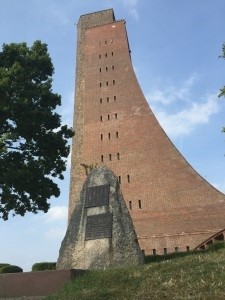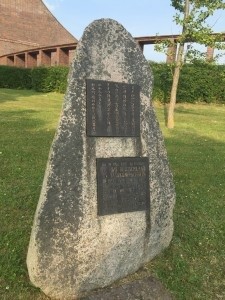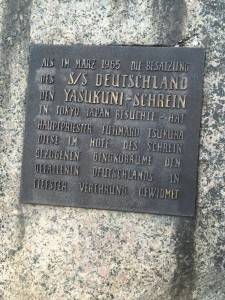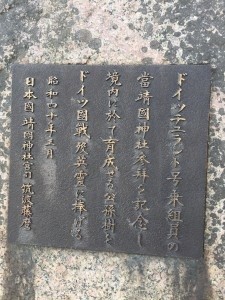From Germany to Yasukuni
- By Peter Harmsen
- 24 July, 2015
- No Comments
 It comes as a bit of surprise: A tablet with a link to Tokyo’s Yasukuni Shrine, set up in front of the German Naval Memorial in the Baltic town of Laboe. It’s all the more surprising since the memorial, originally erected to commemorate German sailors killed in World War I, has seen itself as a monument of peace in the post-1945 years.
It comes as a bit of surprise: A tablet with a link to Tokyo’s Yasukuni Shrine, set up in front of the German Naval Memorial in the Baltic town of Laboe. It’s all the more surprising since the memorial, originally erected to commemorate German sailors killed in World War I, has seen itself as a monument of peace in the post-1945 years.
The tablet stands in front of three gingko trees and reads, in Japanese and in German: “When the crew of the training vessel Deutschland visited the Yasukuni Shrine in Tokyo, Japan, in March 1965, the chief priest Fujimaro Tsukuba dedicated these gingko trees, from the shrine’s yard, to Germany’s fallen (soldiers), in deepest reverence.”
The Deutschland had been put into service in 1963, and the visit to Japan in 1965 was part of a voyage around the globe aimed at generating goodwill in a world that had neither forgotten nor forgiven Germany’s aggressive behavior two decades earlier. When the crew returned home to Germany, it was greeted by the local press as the country’s “ambassadors in blue.”
 Of course, if in today’s world someone were to undertake a trip around the world with the aim of making friends, while also making a very public visit to the controversial Yasukuni Shrine, it would be considered crazy.
Of course, if in today’s world someone were to undertake a trip around the world with the aim of making friends, while also making a very public visit to the controversial Yasukuni Shrine, it would be considered crazy.
However, the existence of the tablet at German Naval Memorial suggests a fact that is sometimes overlooked: The shrine’s notoriety is of somewhat recent date. The range of visitors in the 1950s, 1960s and 1970s is impressive, including Chang Tao-fan, the parliamentary speaker of Taiwan’s parliament, US Rear Admiral Daniel Smith, and chief of the German Air Force Johannes Steinhoff, and many others.
The real change came in 1978 with the decision to enshrine 14 so-called Class A war criminals, including generals and politicians widely held responsible for unleashing a devastating war on Asia.
Despite the potential for controversy that has arisen in the meantime, members of the Navy of the Japanese Self-Defense Force visited the German memorial in 2013 to lay down a wreath and reportedly paid “special attention” to the tablet commemorating the trip to Yasukuni nearly half a century earlier.



 Copyright © 2025
Copyright © 2025
Leave a Reply